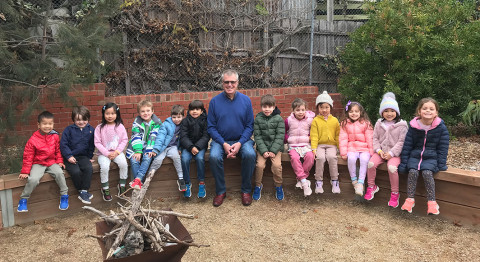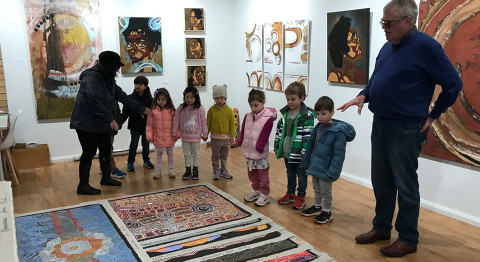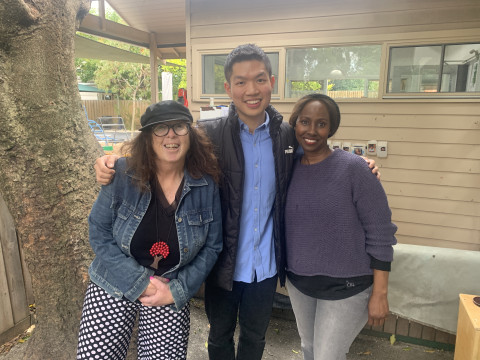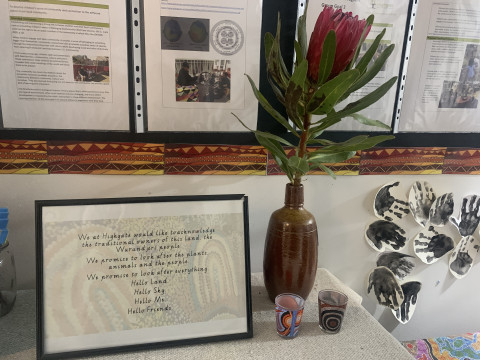Published 09 Jun 2023
Nurturing connection and culture through community partnership at Highgate Early Learning Centre
Engaged with colleagues, school and the broader community
Darren Halim, Mulki Ali and Julie Brunell – Kinder teacher and educators
Highgate Early Learning Centre
Each and every day, Victorian schools and early childhood services go above and beyond to provide quality learning experiences for learners of all ages. The VIT’s Professional Practice team is fortunate to get a first-hand look at the wonderful work of teachers and education professionals, delivering high-quality programs and initiatives across the state. Here is just one example from a Victorian early childhood service.
Located in Melbourne’s east, the team at Highgate Early Learning Centre (ELC) pride themselves on valuing community. The service’s motto ‘Where community spirit shines’ is an integral part of their unique approach, aimed at ensuring strong ties to their local community across all aspects of their curriculum.
Recently, we spoke to teacher Darren Halim about how he and fellow educators Mulki Ali and Julie Brunell established a partnership with a local Wiradjuri artist, Glenn Loughrey.
Q: Can you give some background to the development of your approach to the initiative, including any research or established models / strategies that your approach is based upon?
In Term 1 2022, Julie, my co-educator, told me about a beautiful Aboriginal painting she had been admiring at a local café. At the same time, I was researching local Aboriginal heritage sites in the City of Boroondara. I saw that The Wominjeka (Reconciliation) Garden located in St Oswald Anglican Church was just 700m from our centre. Coincidentally I discovered that the Reverend of the church, Rv. Glenn Loughrey, was the Wiradjuri Artist whose work Julie had been admiring.
The initiative is supported by the Early Years Learning Framework for Australia (2022) and focuses on embedding Aboriginal and Torres Strait Islander perspectives into learning. The framework promotes the notion of building respectful partnerships with local Aboriginal and Torres Strait Islander community members to ensure “a commitment to children learning about what has come before and working together for what is to come” (p. 17). Early childhood educators are positioned as ‘co-learners’ who value the rich opportunities for building knowledge that can come from partnerships with the local community.
The children at Highgate ELC were lucky enough to have multiple meetings with Glenn throughout the year, each involving hands-on experiences that linked to concepts they were learning about in their kinder program.
The first opportunity involved the 4-year-old Kinder program making a visit to the Wominjeka Garden. We sat at the meeting circle and Glenn shared some cultural artefacts with us, including tapping sticks, calamoon (traditional shopping basket or bassinet) and an emu caller. We toured the garden and learned about the different native plants. Glenn explained the way the repetitive circular shape of the garden represented the significance of yarning circles as part of Aboriginal culture. We also had a tour of the Murnong Gallery, which displays some of Glenn’s paintings. Glenn emphasised his deep connection with Country and the way he gets inspiration for painting from the Land.
Glenn also visited the 3-year-old Kinder learners to talk about yarning circles and yarning sticks.
Later in the year, the 4-year-olds participated in a Fire Lab program. Glenn provided an Aboriginal perspective on this theme as he supported us to use the fire pit at the Wominjeka Garden. During our Fire Lab lessons at Highgate, we learned about the danger of smoke, but Glenn explained how in his culture, smoke has the ability to cleanse things. We watched Glenn light up the fire and listened to his stories and anecdotes. We also had a follow-up visit to the fire pit where the children engaged in cooking Johnny Cakes and Bush Scones, as guided by Glenn.
For our last visit of the year, Glenn invited us back to Murnong Gallery to do some dot painting. He explained the process behind his painting and how it can take home over 100 hours to complete a single painting.
Q: What structural things are in place to ensure that the initiative has its best chance at success?
Our approach was informed by Outcome 1: Children have a strong sense of identity, outlined by the Australian Children’s Education & Care Quality Authority (ACECQA) and the National Voice for our Children (SNAICC). We also referenced The Possum Skin Pedagogy, Walking Together and Glenn’s autobiography – On Being a Black Fella’s Young Fella. In building partnerships with Aboriginal and Torres Strait Islander Community members, we were mindful of the potentially ‘high cultural load’ that they may have.
Our team considered the following protocols as we partnered with Glenn (QCAA, 2018):
Understanding the local history
We took the time to learn more about the City of Boroondara's local Aboriginal history, asked Glenn questions and took notes. We tried to connect the pieces of information to understand the bigger picture and to recognise the continuing impact of the history and legacies of Aboriginal and Torres Strait Islander communities in today’s world (ACECQA, 2020).
Linkages to your Kindergarten Program
We established links between Glenn’s visits and our current program to ensure rich and meaningful learning experiences. As part of the 4-year-old Kindergarten program, we run a weekly Bush Kinder and Fire Lab program that enables children to go on frequent outings, have first-hand experience with nature and be involved in risky play. This proved to be a great basis for the learning we experienced with Glenn as they share lots of similarities and room for extensions and provocations.
Making the effort
It took regular and respectful communication to build a strong partnership. I always followed up and scheduled future visits with Glenn and sent him a thank you email for his time and preparations. I shared any relevant learning stories about our visit or the related extensions we did at Kinder, and asked Glenn and his team if there was anything our Kinder could help with. For any of the ideas that Glenn proposed, I tried to implement and report back on the children’s experiences.
It takes time
Building a partnership is a two-way street that takes time to build trust (ACECQA, 2020). Throughout the year, Glenn and our Kinder have become familiar with each other’s working styles and pattern of ideas. It was important to be flexible and mindful of each other’s schedule, workload and priorities in creating times to visit each other.
Q: What are the greatest benefits to staff development of this approach?
For educators, we were provided with a direct source to support us in learning how to embed Aboriginal and Torres Strait Islander cultures into our program in a sensitive manner. It provided the opportunity for us to reflect on and develop our cultural competence.
We were able to build our knowledge of how to make incidental connections to Aboriginal culture throughout the kinder program, including building an appreciation for the land, sharing Aboriginal stories and finding opportunities to teach the children about Aboriginal languages. Staff continually shared ideas and collaborated to ensure a consistent understanding and approach.
Our partnership with Glenn also helped us to be more informed in the process of developing our Reconciliation Action Plan.
Q: What have been the benefits to learner outcomes of this approach? Please provide some illustrative examples if appropriate.
Creating a relationship with our local Aboriginal community is an important factor in building children’s awareness and understanding of Aboriginal culture and perspective in an authentic manner. It sends a strong message to the children, families, and educators of how much our Kinder respects and values Aboriginal and Torres Strait Islander culture.
The 4-year-old learners in my room referred to Glenn often, as he became a regular contributor and another important educator in our small-knit community. The children were highly engaged in the visits with Glenn, and their experiences had an obvious influence on their imaginative play when we returned to the centre. For example, the experience of learning about the fire pit gave the children the idea to “cook fish in the fire” by using a tire to mark the bonfire.
The children also spoke to their families about their experiences and some visited the Murnong Gallery on the weekends.

Glenn Louhrey with learners at Highgate Early Learning Centre

Glenn showing learners traditional artwork at Murnong Gallery

Highgate Early Learning Centre team: Julie Brunell, Darren Halim and Mulki Ali

Framed Acknowledgement of Country at Highgate ELC
Q: What plans does your workplace have to take this approach forward?
Looking ahead, the Highgate team is planning to apply for a Boroondara local grant (i.e. Annual Community Strengthening Grant by City of Boroondara) to hire Glenn on a professional level to do professional development sessions to upskill the educators’ understanding of the local Aboriginal history and culture. We’re also hoping to develop a collaborative artwork dot painting to be displayed at Highgate to symbolise our strong relationship that we have built.
Q: Can you detail any references or citations applicable?
- Promoting, exploring and celebrating Aboriginal and Torres Strait Islander Cultures – ESA Training EYLF Factsheet 1 – ACECQA and SNAICC
- Building relationships with local communities – Queensland Curriculum & Assessment Authority (QCAA)
- The Possum Skin Pedagogy – Dr Sue Atkinson
- Walking Together – The Victorian Aboriginal Education Association Incorporated (VAEAI) and the Victorian Inclusion Agency
- On Being a Black Fella’s Young Fella – Glenn Loughrey
Do you have an example of outstanding work in your school or early childhood service? We’d like to consider showcasing it the Excellence in Teaching section of our website. Send your example and contact details to vitcomms@vit.vic.edu.au.
